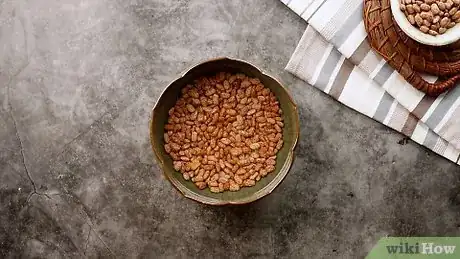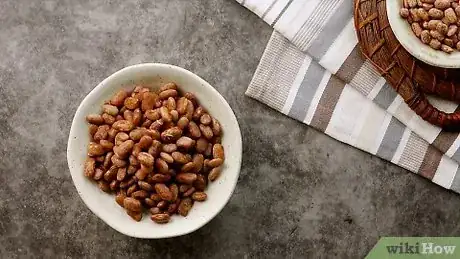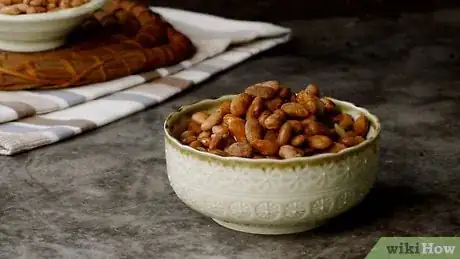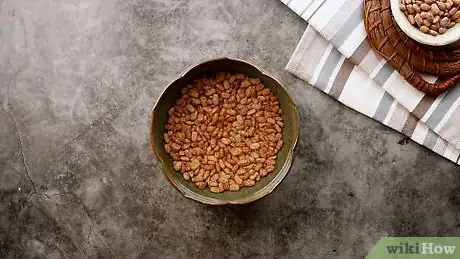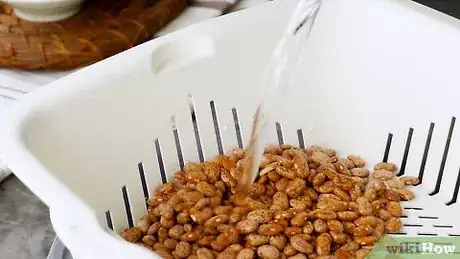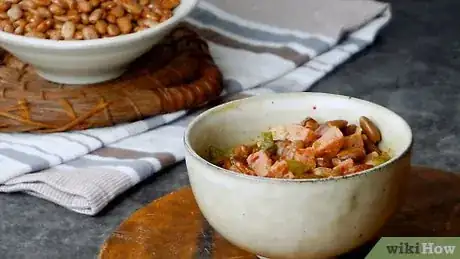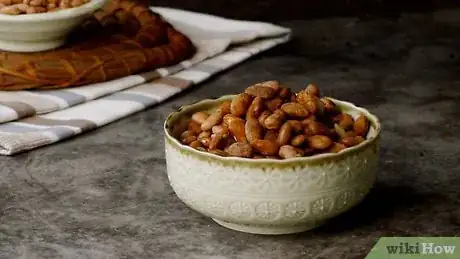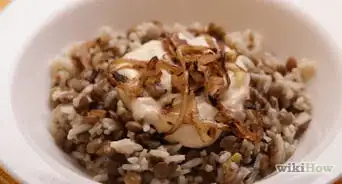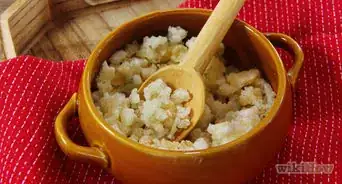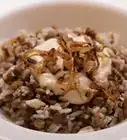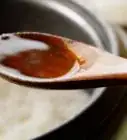wikiHow is a “wiki,” similar to Wikipedia, which means that many of our articles are co-written by multiple authors. To create this article, 9 people, some anonymous, worked to edit and improve it over time.
There are 9 references cited in this article, which can be found at the bottom of the page.
The wikiHow Culinary Team also followed the article's instructions and verified that they work.
This article has been viewed 30,182 times.
Learn more...
Cooking beans at home is an easy way to add delicious flavor and plenty of nutrition to your next meal. High in fiber, protein and antioxidants, beans are not only a versatile foundation to many dishes, but they also offer many health benefits.[1] While you can quickly and conveniently cook with beans straight from the can, by preparing dry beans on the stove top, with a slow cooker or a pressure cooker, you can better control the flavor, additives and variety of the beans you eat without much difficulty.[2]
Steps
Cooking Beans on the Stove Top
-
1Soak the beans. Pour the dry beans into a large bowl and pick through to remove any shriveled or unappealing beans. Cover the beans with two to three inches (5 to 7 cm) of water and leave them on the counter to soak overnight.[3]
- Soaking the beans overnight (roughly 10 to 14 hours) reduces the cooking time required, helps them cook more evenly and makes them easier to digest by removing most of the sugar called oligosaccharide, which causes flatulence. [4]
- If you’re in a rush you can speed up the soaking time by covering the beans in water, heating them to a boil for two minutes, then turn off the heat and allow them to sit undisturbed for an hour.[5]
- Lentils, peas, and black-eyed peas do not need to be soaked before cooking.
-
2Drain the soaked beans. Pour the beans into a colander to remove the soaking water. Rinse them under cold running water.Advertisement
-
3Move the beans to a cooking vessel. Transfer the beans to a dutch oven or heavy cooking pot.
- At this point you can add aromatics if you wish, such as half of an onion, garlic cloves, chopped carrots and/or bay leaves.
-
4Bring the beans to a boil. Cover the beans with fresh water and place the cooking vessel on the stove top. Bring the water to a boil over medium-high heat for a few minutes.
-
5Simmer the beans. Reduce the heat to low and bring the beans to a very gentle simmer; you should barely be able to see the water moving.
- Cover the cooking vessel with a lid that is slightly ajar for creamier beans used in soups, stews and burritos.
- Leave the lid off the cooking vessel if you want firmer beans for salads and pasta dishes.
-
6Cook the beans. Simmer the beans according to the recommended cooking time for the particular variety.[6]
-
7Add salt if desired. Once the beans are just barely tender and nearly done cooking, you can add salt for flavor.
- Avoid adding the salt too early as it can prevent the beans from becoming tender.
-
8Use or store the beans. You can now add your cooked beans to any recipe. If you wish to store them, measure out 1 1/2 cups (354.8 ml) of beans into a two cup storage container and the cooking liquid to cover, allowing 1/2 inch (1.27 cm) of headspace. Seal and store in the refrigerator for one week or in the freezer for up to one year.
- Label the containers with the date and contents.
Cooking Beans in a Pressure Cooker
-
1Soak the beans. Pour the dry beans into a large bowl and pick through them to remove any shriveled or unappealing beans. Cover the beans with two to three inches (5 to 7 cm) of water and leave them on the counter to soak overnight.[7]
- Soaking the beans overnight (roughly 10 to 14 hours) reduces the cooking time required, helps them cook more evenly and makes them easier to digest by removing most of the sugar called oligosaccharide, which causes flatulence. [8]
- If you’re in a rush you can speed up the soaking time by covering the beans in water, heating them to a boil for two minutes, then turn off the heat and allow them to sit undisturbed for an hour.[9]
- Lentils, peas, and black-eyed peas do not need to be soaked before cooking.
-
2Drain the soaked beans. Pour the beans into a colander to remove the soaking water. Rinse them under cold running water.
-
3Move the beans to the pressure cooker. Add eight cups (1.9 L) of water for one pound (453.5 g) of beans.
- At this point you can add aromatics if you wish, such as half of an onion, garlic cloves, chopped carrots and/or bay leaves.
-
4Cook the beans. Secure the cover to the pressure cooker according to the instruction manual and turn the stove top burner up to high. When the pressure cooker reaches high pressure, reduce the heat to medium and start the cooking time. Cook for the recommended time for the beans you are using.[10]
-
5Turn off the heat and allow pressure to reduce. Allow the pot to cool down and reduce the pressure naturally. Follow the instruction manual to know when it is safe to remove the lid.
-
6Remove the lid. Unlock and carefully remove the lid, tilting it away from you and allowing condensation to drip back into the pot. Use a slotted spoon to remove the aromatics.
-
7Use or store the beans. You can now add your cooked beans to any recipe. If you wish to store them, measure out 1 1/2 cups (354.8 ml) of beans into a two cup storage container and the cooking liquid to cover, allowing 1/2 inch (1.27 cm) of headspace. Seal and store in the refrigerator for one week or in the freezer for up to one year.
- Label the containers with the date and contents.
Cooking the Beans in a Slow Cooker
-
1Soak the beans. Pour the dry beans into a large bowl and pick through them to remove any shriveled or unappealing beans. Cover the beans with two to three inches (5 to 7 cm) of water and leave them on the counter to soak overnight.[11]
- Soaking the beans overnight (roughly 10 to 14 hours) reduces the cooking time required, helps them cook more evenly and makes them easier to digest by removing most of the sugar called oligosaccharide, which causes flatulence. [12]
- If you’re in a rush you can speed up the soaking time by covering the beans in water, heating them to a boil for two minutes, then turn off the heat and allow them to sit undisturbed for an hour.[13]
- Lentils, peas, and black-eyed peas do not need to be soaked before cooking.
-
2Drain the soaked beans. Pour the beans into a colander to remove the soaking water. Rinse them under cold running water.
-
3Transfer the beans to the slow cooker. Pour enough water over the beans to cover them by about two inches (5 cm) of water.
- You can add aromatics if you wish, such as half of an onion, garlic cloves, chopped carrots and/or bay leaves.
-
4Cook the beans. Set the slow cooker to the low setting and cook the beans for six to eight hours. Begin checking the beans after five hours and then every 30 minutes until they are cooked to the desired texture.[14]
- In the final stage of cooking you can add salt to taste.
-
5Use or store the beans. You can now add your cooked beans to any recipe. If you wish to store them, measure out 1 1/2 cups (354.8 ml) of beans into a two cup storage container and the cooking liquid to cover, allowing 1/2 inch (1.27 cm) of headspace. Seal and store in the refrigerator for one week or in the freezer for up to one year.
- Label the containers with the date and contents.
Cooking Canned Beans on the Stovetop
-
1Drain the soaked beans. Open the can of beans, pour the beans into a colander and rinse them under cold running water.
-
2Prepare the pot for the beans. Place a dutch oven or heavy cooking pot on the stovetop and turn the height to medium. Add a high-heat cooking oil, such as safflower or coconut oil, and heat for one to two minutes.
- At this point you can add aromatics if you wish, such as chopped onions, garlic cloves, carrots or other seasonings.[15]
-
3Add the beans to the cooking vessel. Heat the beans to a low simmer and stir occasionally.
- You can also add water or stock to the beans if you want more of a sauce consistency or are making soup.
-
4Cook the beans. Canned beans come precooked, so you really just need to heat the beans to the desired temperature for three to five minutes.
-
5Finished.
Community Q&A
-
QuestionWhy do my cans of black beans say that they should be gently reheated and not allowed to boil? I presume its a texture thing and not a health risk?
 Community AnswerYes, it is not a health risk. They were most likely boiled already, since they are soft. You may note if you boil them that they start to separate from their thin skin and form a mushy, muddy mess with the rest of the water.
Community AnswerYes, it is not a health risk. They were most likely boiled already, since they are soft. You may note if you boil them that they start to separate from their thin skin and form a mushy, muddy mess with the rest of the water.
Warnings
- If you are cooking kidney beans, boil them for 10 minutes before cooking to neutralize the toxin phytohemagglutinin, which can cause acute digestive distress.⧼thumbs_response⧽
- Use care when using a pressure cooker and follow the instruction manual closely to avoid injury.⧼thumbs_response⧽
- Do not leave beans cooking unattended, unless using a slow cooker, in which case place the slow cooker away from walls or other appliances.⧼thumbs_response⧽
Things You’ll Need
- Large bowl
- Colander
- Heavy-bottomed pot or Dutch Oven
- Measuring cups
- Wooden spoon
- Knife
- Cutting board
- Slow cooker
- Pressure cooker
- Storage containers
References
- ↑ http://www.webmd.com/diet/features/beans-protein-rich-superfoods
- ↑ https://www.thekitchn.com/make-or-buy-canned-vs-homemade-148729
- ↑ https://www.thekitchn.com/how-to-cook-beans-on-the-stove-182717
- ↑ http://www.treehugger.com/green-food/beans-beans-the-magical-fruit-how-to-eat-them-without-the-flatulence.html
- ↑ http://www.bonappetit.com/test-kitchen/cooking-tips/article/the-faster-way-to-soak-beans-for-cooking
- ↑ http://www.chezbettay.com/pages/basics1/basics_beans1.html
- ↑ https://www.thekitchn.com/how-to-cook-beans-on-the-stove-182717
- ↑ http://www.treehugger.com/green-food/beans-beans-the-magical-fruit-how-to-eat-them-without-the-flatulence.html
- ↑ http://www.bonappetit.com/test-kitchen/cooking-tips/article/the-faster-way-to-soak-beans-for-cooking
- ↑ http://www.hippressurecooking.com/pressure-cooking-times/
- ↑ https://www.thekitchn.com/how-to-cook-beans-on-the-stove-182717
- ↑ http://www.treehugger.com/green-food/beans-beans-the-magical-fruit-how-to-eat-them-without-the-flatulence.html
- ↑ http://www.bonappetit.com/test-kitchen/cooking-tips/article/the-faster-way-to-soak-beans-for-cooking
- ↑ http://www.thekitchn.com/how-to-cook-beans-in-the-slow-cooker-74529
- ↑ http://www.ourbestbites.com/2008/07/quick-and-easy-black-beans/
About This Article
To cook beans on a stove top, start by soaking them in 2-3 inches of water overnight. Next, drain the soaked beans and transfer them to a dutch oven or heavy cooking pot. Then, cover the beans with fresh water and bring them to a boil. Finally, reduce the heat to low and simmer them according to the time suggested on the packaging. Once they get tender, you can add the cooked beans to any recipe. For tips on cooking beans with other techniques, like in a pressure cooker or slow cooker, read on!
